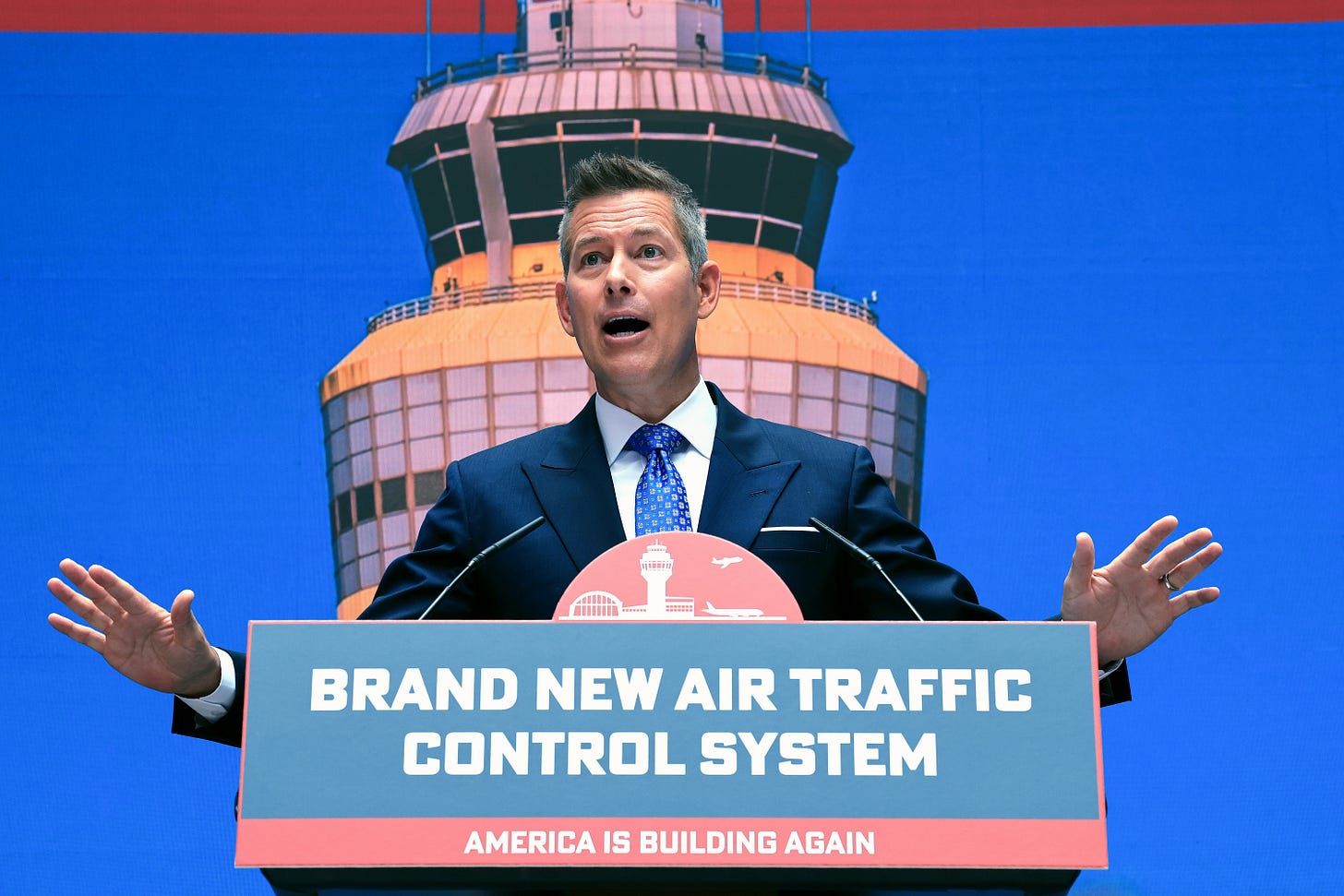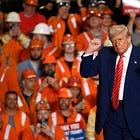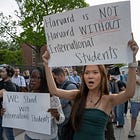Trump's war on cities
First he tells us they're hellholes, then he tries to make them worse.
✈️ 🚝 🚗 This free edition of PN is made possible by paid subscribers. If you appreciate our fiercely independent coverage of American politics, please support us by clicking the button and signing up for a paid subscription. 👇
Going purely by biography, Donald Trump is the most urban of presidents. Raised in Queens, he spent much of his life thirsting for nothing so much as praise and acceptance from the Manhattan establishment, something that forever eluded him.
But as president, he’s waging a steadily growing war on cities and all they represent.
Fomenting anti-urban resentment is nothing new for Trump’s party, but in this most unbound of presidencies, the war is both practical and rhetorical, reaching high and low with dramatic funding cuts and petty vindictiveness.
Consider congestion pricing in New York City, in which drivers are charged a toll for bringing vehicles into central Manhattan at busy times of the day. In its short time in operation it has been an extraordinary policy success: Traffic is moving faster, accidents and noise complaints are down, more visitors are coming, and the money being generated by the tolls will help pay for upgrades to the public transportation system, where ridership is up. So, naturally, the Trump administration is determined to force the city to end the policy (that effort is tied up in the courts).
Why do they even care? Urbanism in any form seems to strike them as an affront. If we have to have these despicable concentrations of humanity, at least they should be built so that if you’re forced to go there you never have to leave your car.
Liberals “want you to take public transportation,” Transportation Secretary Sean Duffy huffed recently on Fox Business. “The problem is that it’s dirty! You have criminals, it’s homeless shelters, it’s insane asylums … it’s a work ground for the criminal element to prey upon the good people.”
But despite what Duffy claims, millions of people ride the New York subways every day and somehow emerge with life and limb intact.
People living in rural areas and small towns are constantly told by conservative politicians and media figures they trust that American cities are hellholes of violence and decay, so they come to believe that if they set foot in a large city their chances of surviving even a few minutes are iffy at best. When I made this point on Bluesky, dozens of people replied that this is exactly what relatives or friends of theirs believe.
“We live in San Diego. My dad & stepmom in rural TN are scared to come visit ‘because of what could happen,’” said one. “I live in a city of 100,000 in Arkansas,” said another. “I have co-workers who live in tiny outlying towns who won’t go to downtown restaurants after dark because they are scared.”
As it happens, crime has fallen precipitously since the covid spike of 2020 and 2021, and 2025 could see some of the lowest crime rates in modern times. The covid crime spike hit rural areas too, though few seemed to notice. That’s especially true when it comes to conservative media, where histrionic coverage of urban crime is a mainstay (especially at election time). And while crime does happen on the New York subway, it’s also a place where all the riders on a car will swing into action together to corral a bag full of live crabs.
A note from Aaron: Working with brilliant contributors like Paul takes resources. If you aren’t already a paid subscriber, please sign up to support our work.
“You get shot, you get mugged, you get raped”
Few prominent figures talk more often about urban crime than the president himself, whose view of the city he grew up in seems frozen in the New York of Charles Bronson’s 1970s “Death Wish” movies, in which an angry white man goes around the city blasting away at black and brown toughs.
Though crime is dramatically down since then — while there were over 2,000 homicides per year in New York City in the early 1990s, in 2024 there were just 377 in the city of eight a half million people, and 2025 looks to be even lower — Trump either doesn’t believe it or knows how powerful the picture of the murderous city can be.
“You can’t walk across the street to get a loaf of bread,” he would say during last year’s campaign. “You get shot, you get mugged, you get raped.” (The clip below is from a campaign stop he made in Michigan last August.)
Trump’s running mate JD Vance went to Minneapolis during the campaign, called it “overrun with crime,” and said that if Kamala Harris were elected, this same horror “is coming to every community across the United States of America.”
While Trump hasn’t announced an anti-urban agenda, that’s what many of the policies being pushed by his administration and Congress amount to, and the attack on New York’s congestion pricing is just one example. Republicans are planning dramatic cuts to housing assistance and a variety of transportation programs, including one that helps cities undo the harms caused to neighborhoods when they were bisected by highways. The administration wants to pull grants and contracts from “sanctuary cities” that aren’t providing enough support for its mass deportation program.
But the biggest urban assault of all may be contained within Trump’s other budget cuts and his war on higher education. Many cities that were once industrial hubs now have economies built on “Eds and Meds” — universities and hospitals. Think Pittsburgh, where the largest employers in its county are the University of Pittsburgh Medical Center and the University of Pittsburgh, while US Steel ranks all the way down at number 18. (In fact, UPMC subsidiaries account for nine of the top 50 employers in Allegheny County; it bestrides southwestern Pennsylvania like a colossus.)
As Jonathan Zasloff observes, “what are two industries that the administration has focused on destroying? Eds and meds.” When the administration pulls funding from universities and guts the nation’s capacity for medical research, cities and their economies will be hit particularly hard.
Cities really are liberal, and there’s nothing wrong with that
When Republicans feel in their guts that there’s something inherently liberal about urban life that goes beyond who runs the government in most cities, they aren’t wrong.
Cities change rapidly and continuously in ways suburbs and rural areas don’t, both physically and demographically; if you want to live in a place that will be the same as it was when you were a kid, the city isn’t for you. The fact of living in close quarters with so many others involves both voluntary and involuntary restrictions on your freedom, and to negotiate that coexistence, you have to check yourself. You can’t play your music as loud as you want, or tear down the road as fast as you want, or set off fireworks outside your house.
Cities are also where most immigrants end up, and where people looking for economic opportunity or acceptance are drawn. The resulting diversity requires you to learn to live with many different kinds of people. The Queens of Donald Trump’s youth was embodied in Archie Bunker, the unashamedly bigoted protagonist of “All in the Family.” Today, Queens may be the most ethnically and linguistically diverse spot on the planet. Archie would have moved to the suburbs long ago, and regaled anyone who would listen with tales of how awful his former home had become.
The idea of the dangerous city is woven through the culture conservatives promote. It was just two years ago that “bro country” star and Trump supporter Jason Aldean released “Try That In a Small Town,” which told the story of urbanites bringing their mayhem to a small town, which would be met with violence that sounds a lot like lynching (“That shit might fly in the city/Good luck/Try that in a small town/See how far you make it down the road”). The video showed scenes of urban violence set against gentle rural idylls of families and buddies going hunting.
The song was hyped on Fox News and played at rallies for Republican candidates, and though Aldean’s advocates claimed he had been “cancelled,” in fact, “Try That In A Small Town” became the biggest crossover hit of his career, reaching number one on the Billboard Hot 100. His tale of urban crime and rural belligerence wasn’t particularly original, but it was catnip for the political right, which is always looking to claim authenticity by pitting rural against urban and siding with the former.
What we have, then, is a multiplicity of political forces — culture, media, politics — pushing in the same direction. When Democrats like Joe Biden take office, they not only praise the “heartland,” they enact policies meant to improve life there, desperately trying to show that they aren’t urban elitists. But when Republicans assume power, their rhetorical war on cities gets turned into policy. And as with just about everything in Trump’s second presidency, this version is worse than ever.
That’s it for today
We’ll be back with more tomorrow. If you appreciate today’s newsletter, please support our work by signing up. Paid subscribers make Public Notice possible.
Thanks for reading, and for your support.







I am tired of this constant attempt to divide people based on things that are blown out of proportion. I grew up in St Louis, moved to a medium-sized town in Texas, then a medium-sized city in TN, back to Texas, back to TN and then to small towns in CT. While I enjoyed different things in Texas, TN and CT, when it came time to retire I headed back to St Louis County. There are so many things to do here that aren't available in medium and small towns. I'm attending a docent tour of the St Louis Art Museum (built for the 1904 World's Fair), I walk through our fantastic Botanical Garden, visit our History Museum, our Zoo, a nearby sculpture park, a Frank Lloyd Wright home, our public library and other historic buildings in St Louis, the Muny (outside musicals), I have season tickets for a nearby university that has a repertory theatre, and I could go on and on and on. I also see physicians who are part of Washington University/Barnes Jewish Hospital. Cities, and the surrounding areas, offer so much and, parking is almost always free. I think people enjoy what they grew up with, but it shouldn't be a "good" vs "bad" situation; that's just plain stupid.
Cities are also where these right wing maga anti-urban propagandists end up - living well as they foment rural resentment against their lifestyle.